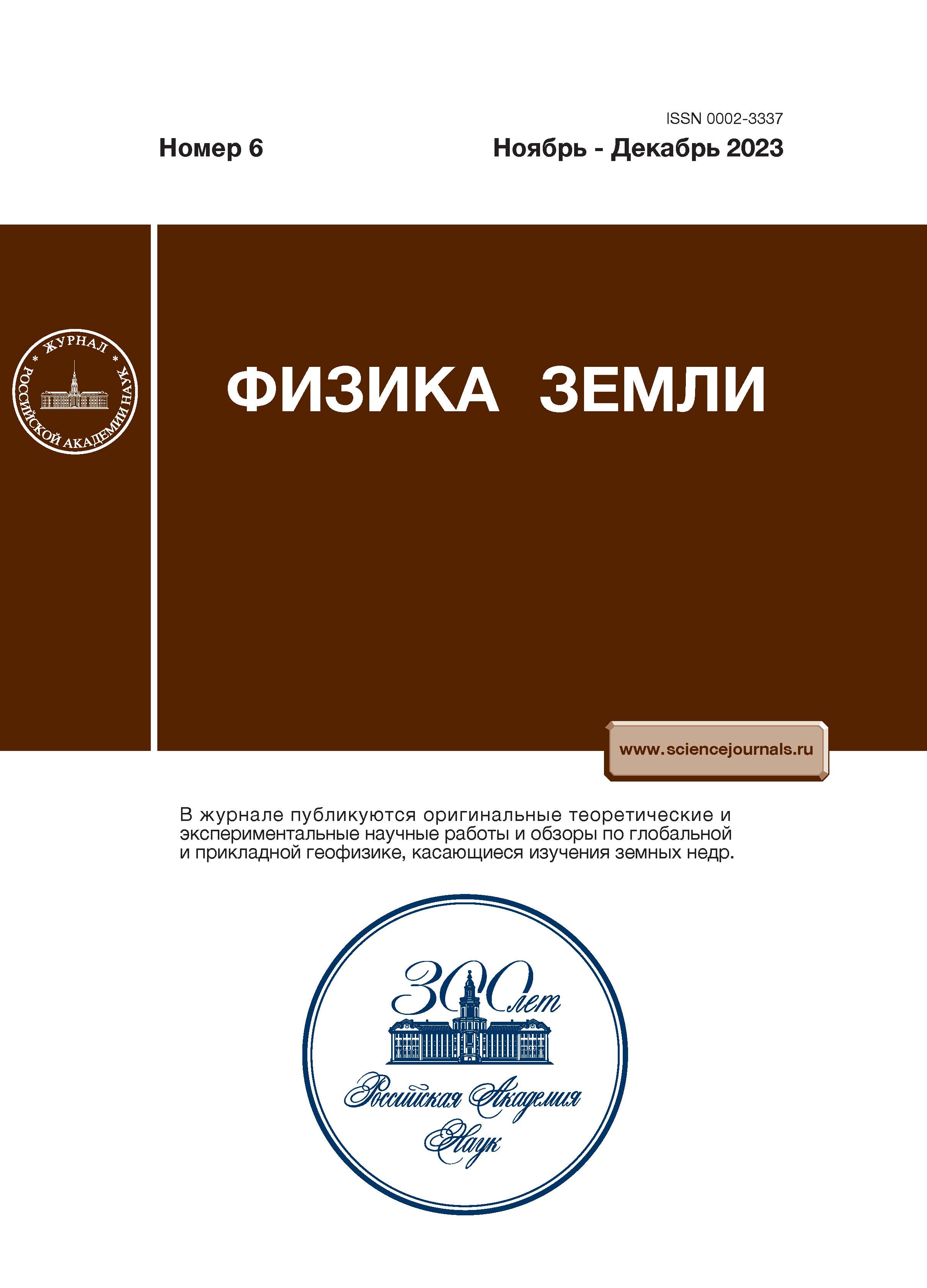Preliminary Seismo-Tectonic Analysis of the Catastrophic Earthquake in South-Eastern Turkey on Feb 6, 2023
- Authors: Simonov D.A.1, Zakharov V.S.1
-
Affiliations:
- Lomonosov Moscow State University
- Issue: No 6 (2023)
- Pages: 24-36
- Section: Articles
- URL: https://journals.rcsi.science/0002-3337/article/view/249482
- DOI: https://doi.org/10.31857/S0002333723060194
- EDN: https://elibrary.ru/YMSNQP
- ID: 249482
Cite item
Abstract
Abstract
—In this paper, we carried out a kinematic analysis of the movements of plates and blocks of the region based on a homogeneous database of displacement velocities of GNSS permanent monitoring stations for the region of southeastern Turkey, where strong earthquakes occurred on February 6, 2023. Along the East Anatolian fault zone from 2008 to 2018, the Arabian Plate was established to shift relative to the Anatolian Plate, corresponding to a left shift (without a normal component) at a rate of 1 cm/yr in the eastern part to 0.8 cm/yr in the western part. Displacements occurred along the Chardak fault, corresponding to a left-hand strike-slip fault, at a rate of less than 0.7 cm/year. The revealed kinematics is confirmed by focal mechanisms and cosesismic displacements of the studied earthquakes. The M7.5 earthquake that occurred directly on the Chardak fault is not an aftershock of the M7.8 earthquake, but is a relatively independent event. An analysis of the seismic regime shows that the stresses on the East Anatolian fault after the main event M7.8 are relieved by the first large latitudinal fault zone (the Chardak fault). The results of our study suggest that the counterclockwise rotation of the Anatolian and Arabian plates associated with the opening of the Red Sea Rift is most likely decisive for the general kinematics of the plates in the region.
About the authors
D. A. Simonov
Lomonosov Moscow State University
Author for correspondence.
Email: dsim_0@mail.ru
Russia, 119991, Moscow
V. S. Zakharov
Lomonosov Moscow State University
Author for correspondence.
Email: zakharov@geol.msu.ru
Russia, 119991, Moscow
References
- Бачманов Д.М., Кожурин А.И., Трифонов В.Г. База данных активных разломов Евразии // Геодинамика и тектонофизика. 2017. № 8(4). С. 711–736. https://doi.org/10.5800/GT-2017-8-4-0314
- Завьялов С.П., Захаров В.С. Блоковая структура земной коры по данным GPS. Геологическая среда, минерагенические и сейсмотектонические процессы. Материалы XVIII международной научно-практической конференции 24–29 сентября 2012 г. Воронеж: Научная книга. 2012. С. 126–130.
- Захаров В.С., Симонов Д.А. Анализ современных дискретных движений блоков земной коры геодинамически активных областей по данным GPS // Вестн. Моск. ун-та. Сер. 4. Геология. 2010. № 3. С. 25–31.
- Захаров В.С., Симонов Д.А., Коптев А.И. Количественная оценка потенциальных сейсмогенных оползневых смещений (на примере Сочи-Краснополянского района и Горного Алтая) // Динамическая геология. Электронный научно-образовательный журнал. 2022. № 1. С. 34–58. http://www.geodisaster.ru/uploads/images/Dynamic/Журнал2022_1.pdf (дата обращения 30.05.2023).
- Aktug B., Ozener H., Dogru A. et al. Slip rates and seismic potential on the East Anatolian Fault System using an improved GPS velocity field // J. Geodyn. 2016. V. 94–95. P. 1–12. https://doi.org/10.1016/j.jog.2016.01.001
- Alchalbi A., Daoud M., Gomez F. et al. Crustal deformation in northwestern Arabia from GPS measurements in Syria: Slow slip rate along the northern Dead Sea Fault // Geoph. J. International. 2010. V. 180. №1. P. 125–135. https://doi.org/10.1111/j.1365-246X.2009.04431
- Bird P. An updated digital model of plate boundaries // Geochem., Geophys., Geosyst. 2003. V. 4. № 3. P. 1027. https://doi.org/10.1029/2001GC000252
- Continuously operating reference stations-Turkey (CORS-TR). http://cors-tr.iku.edu.tr. (дата обращения 30.04.2023).
- Duman T.Y., Emre Ö. The East Anatolian Fault: geometry, segmentation and jog characteristics // Geological Society, London, Special Publications. 2013. V. 372. P. 495–529. https://doi.org/10.1144/SP372.14
- Duman T.Y., Çan T., Emre Ö. et al. Seismotectonic database of Turkey // Bull. Earthquake Eng. 2018. V. 16. P. 3277–3316. https://doi.org/10.1007/s10518-016-9965-9
- Emre Ö., Duman T.Y., Özalp S. et al. Active fault database of Turkey // Bulletin of Earthquake Engineering. 2018. V. 16(8). P. 3229–3275. https://doi.org/10.1007/s10518-016-0041-2
- European-Mediterranean Seismological Centre (EMSC). https://www.emsc-csem.org/Earthquake/info.php (дата обращения 30.04.2023).
- Hancılar U., Şeşetyan K., Çaktı E. et al. Kahramanmaraş – Gaziantep Türkiye M7.7 Earthquake, 6 February 2023. Strong Ground Motion and Building Damage Estimations Preliminary Report (v6). Boğaziçi University. 2023. 46 p.
- Lekkas E., Carydis P., Vassilakis E. et al. The 6 February 6 2023 Turkey-Syria Earthquakes. Newsletter of Environmental, Disaster and Crises Management Strategies. 2023. № 29. 202 p. https://doi.org/10.13140/RG.2.2.17643.82726
- National Earthquake Information Center (NEIC) USGS. https://earthquake.usgs.gov/earthquakes/search/ (дата обращения 30.04.2023).
- Özdemir S. On the Estimation of Precise Coordinates and Velocities of TNPGN and TNPGN Active Stations // General Command of Mapping J. 2016. V. 155. P. 53–81.
- Özdemir S., Karslıoğlu M. Soft clustering of GPS velocities from a homogeneous permanent network in Turkey// J. Geodesy. 2019. V. 93. P. 1171–1195. https://doi.org/10.1007/s00190-019-01235-z
- Richard S., Pagani M. The GEM Global Active Faults Database // Earthquake Spectra. 2020. V. 36. № 1. P. 160–180. https://doi.org/10.1177/8755293020944182
Supplementary files
















